Sökresultat
Filtrera
Filtyp
Din sökning på "*" gav 534592 sökträffar
Oligosaccharide mapping of proteoglycan-bound and xyloside-initiated dermatan sulfate from fibroblasts
The copolymeric structure of dermatan sulfate chains synthesized by skin fibroblasts has been examined. Chains initiated onto exogeneous p-nitrophenyl-beta-D-xylopyranoside or attached to protein in a large proteoglycan, PG-L, and two small proteoglycans, PG-S1 and PG-S2, have been compared by using high resolution electrophoresis and gel chromatography of oligosaccharides generated by specific en
The European Frontier : Clashes and Compromises in the Middle Ages
During the Middle Ages the concepts of `them and us' became concrete in the shape of fiercely defended frontiers, some of which were physical, geographic and political, while others were more ideological. This volume, the proceedings of an international symposium held at Lund University in 2000, presents twenty-four papers which examine the archaeological evidence for frontiers across Europe. Divi
ST analysis
A comparison of chironomid biostratigraphy from Lake Vuolep Njakajaure with vegetation, lake-level, and climate changes in Abisko National Park, Sweden
Chironomid remains from the sediment of Lake Vuolep Njakajaure reflect limnological conditions resulting from changing climate and vegetation throughout the Holocene, but do not strictly follow accepted climate trends or the vegetation history based on regional pollen and macrofossil analyses. Chironomid community changes appear to be influenced by organic nutrient input from the surrounding catch
Relaxation kinetics of an L-3 (sponge) phase
The kinetic response of an L-3 (sponge) phase formed in the C12E5-n-decane-brine system is studied using the Joule-heating temperature jump (JHTJ) technique. The equilibrium state of the spongelike membrane is instantaneously perturbed, and the kinetic response is monitored using a multi-angle light scattering setup. These measurements yield a time-dependent scattering intensity as a function of t
Demonstration of sequence variations in the promoter region of the human cystatin C gene
Four point mutations in the promoter region of the human cystatin C gene have been detected by direct sequencing of polymerase chain reaction (PCR) amplified DNA. The four base changes are all localized within a short segment of 85 base pairs. Three cystatin C gene alleles could be defined with respect to these promoter mutations; one with the sequence previously published, one carrying three of t
LIFE SATISFACTION AND FEELING HINDERED BY HEALTH PROBLEMS AT 60 YEARS AND ABOVE
Popular Abstract in Swedish Idag finns det flera studier där livstillfredsställelse bland äldre har undersökts. Studierna är dels genomförda i varierande kontext och dels innehåller de varierande faktorer som hälsa, funktionell förmåga, självkänsla, sociala kontakter och finansiell situation. Därmed är det inte självklart att det finns gemensamma eller specifika faktorer, vilka är förknippade med The aim of this thesis was to investigate how older people's capacity to perform activities of daily living (ADL), health, social and financial resources, and self-esteem can be related to their life satisfaction. The aim was also to investigate how people feel hindered by health problems in relation to their ADL capacity, health problems, social and financial resources, self-esteem, sense of cohe
Search for new physics in e +/- q contact interactions at HERA
Deep-inelastic e(+/-) p scattering at high squared momentum transfer Q(2) up to 30 000 GeV2 is used to search for eq contact interactions associated to scales far beyond the HERA centre of mass energy. The neutral current cross section measurements dsigma / dQ(2), corresponding to integrated luminosities of 16.4 pb(-1) of e(-) p data and 100.8 pb(-1) of e(+) p data, are well described by the Stand
Water flow through porous materials. P. 3, Applications of the relative suction model
A 3-dimensional absorbed dose calculation method based on quantitative SPECT for radionuclide therapy: evaluation for (131)I using monte carlo simulation.
A general method is presented for patient-specific 3-dimensional absorbed dose calculations based on quantitative SPECT activity measurements. METHODS: The computational scheme includes a method for registration of the CT image to the SPECT image and position-dependent compensation for attenuation, scatter, and collimator detector response performed as part of an iterative reconstruction method. A
The Late Holocene history of beech Fagus sylvatica and Norway spruce Picea abies at stand-scale in southern Sweden
Popular Abstract in Swedish Denna avhandling är resultatet av min doktorandutbildning vid Kvartärgeologiska avdelningen, Geologiska institutionen, Lunds universitet. Avhandlingen baseras på pollenanlytiska undersökningar av ett antal lokaler i södra Sverige. I denna syntes sammanfattas resultaten av undersökningarna. Introduktion och bakgrund Avsikten med avhandlingen har varit att studera etablHigh resolution pollen analysis was carried out on five peat profiles from small forest hollows at four sites in southern Sweden. The general aim was to investigate the establishment of Fagus sylvatica and Picea abies at stand-scale. The sites used for this study were all located within the area where the present distribution limits of Fagus and Picea overlap each other. The results from the diffe
Miljövänlig kollektivtrafik. Exempel från Malmöhus län
Carl Wilhelm von Sydow som folklorist
Changes in ultraviolet-radiation reaching the earths surface
The quality and quantity of UV measurements have increased greatly in the last few years. Variations among measurements from different instruments are diminishing toward the 5% level. Long-term trend detection is still a problem, with little historical data available for baseline estimations. Enhanced UV levels are clearly associated with the Antarctic springtime ozone reductions. Measurements sho
Neuropathological postmortem evaluation of BNCT for GBM
Background - Thirty patients with glioblastoma multiforme (GBM) were treated by boron neutron capture therapy (BNCT) at the Studsvik facility in Sweden, in a clinical trial exploring a procedure in which 900 mg p-boronophenylalanine (BPA) per kilo body weight was infused in 6 h. Objective - The present study was designed to assess tumor efficacy and radiation damage to the brain for the seven pati
